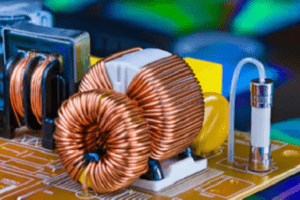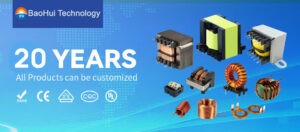What is an Inverter?
An inverter converts the DC voltage to an AC voltage. In most cases, the input DC voltage is usually lower while the output AC is equal to the grid supply voltage of either 120 volts, or 240 Volts depending on the country.
The inverter may be built as standalone equipment for applications such as solar power, or to work as a backup power supply from batteries which are charged separately.
The other configuration is when it is a part of a bigger circuit such as a power supply unit, or a UPS. In this case, the inverter input DC is from the rectified mains AC in the PSU, while from either the rectified AC in the in the UPS when there is power, and from the batteries whenever there is a power failure.
There are different types of inverters based on the shape of the switching waveform. These have varying circuit configurations, efficiencies, advantages and disadvantages
An inverter provides an ac voltage from dc power sources and is useful in powering electronics and electrical equipment rated at the ac mains voltage. In addition they are widely used in the switched mode power supplies inverting stages. The circuits are classified according the switching technology and switch type, the waveform, the frequency and output waveform.
Basic inverter operation
The basic circuits include an oscillator, control circuit, drive circuit for the power devices, switching devices, and a transformer.
The conversion of dc to alternating voltage is achieved by converting energy stored in the dc source such as the battery, or from a rectifier output, into an alternating voltage. This is done using switching devices which are continuously turned on and off, and then stepping up using the transformer. Although there are some configurations which do not use a transformer, these are not widely used.
The DC input voltage is switched on and off by the power devices such as MOSFETs or power transistors and the pulses fed to the primary side of the transformer. The varying voltage in the primary induces an alternating voltage at secondary winding. The transformer also works as an amplifier where it increases the output voltage at a ratio determined by the turn’s ratio. In most cases the output voltage is raised from the standard 12 volts supplied by the batteries to either 120 Volts or 240 volts AC.
The three commonly used Inverter output stages are, a push-pull with centre tap transformer, push-pull half-bridge, or push-pull full bridge. The push pull with centre tap is most popular due to its simplicity and, guaranteed results; however, it uses a heavier transformer and has a lower efficiency.
A simple push pull DC to AC inverter with centre tap transformer circuit is a shown in the figure below.
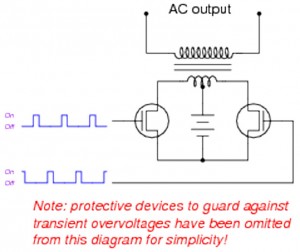
Figure 1 basic inverter switching circuit
Inverter output waveforms
The inverters are classified according to their output waveforms with the three common types being the square wave, the pure sine wave and the modified sine wave.
The square wave is simple and cheaper, however, it has a low power quality compared to the other two. The modified square wave provides a better power quality (THD~ 45%) and is suitable for most electronic equipment. These have rectangular pulses that have dead spots between the positive half cycle and the negative half cycle (THD about 24%).
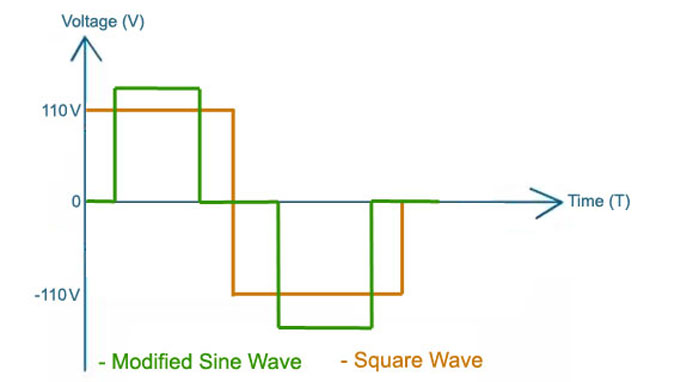
Figure 2: Modified sine waveform
The true sine wave inverter has the best waveform with the lowest THD of about 3%. However, It is the most expensive and used in applications such as medical equipment, stereos, laser printers and other applications requiring sinusoidal waveforms. These are also used in the grid ties inverters and grid connected equipment
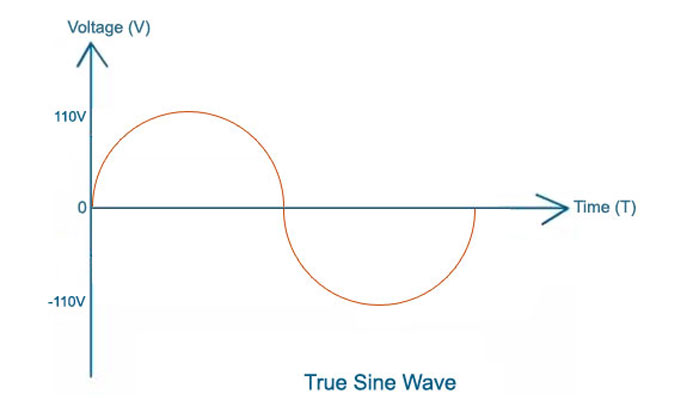
Figure 3: Pure Sine wave
Applications
Inverters are used for a variety of applications that range from small car adapters to household or office applications, and large grid systems.
- Uninterruptible power supplies
- As standalone inverters
- In solar power systems
- As a building block of a switched mode power supply
Benefits
1. Energy-saving
Fan and pump applications benefit significantly from AC drives. Superior to dampers and on/off controls, using AC drives can reduce energy consumption by 20 to 50 percent by controlling motor rotation. It is similar to reducing the speed of a car. Instead of using breaks, the speed of the car can be reduced by lightly pressing on the accelerator.
2. Soft Starters
An AC Drive starts the motor by delivering power at a low frequency. It gradually increases the frequency and motor speed until the desired speed is met. Operators can set the acceleration and deceleration at any time, which is ideal for escalators and conveyor belts to avoid dropouts of loads.
3. Controlled Starting Current
It takes seven to eight times of the AC motor’s full-load current to start the motor. The AC drive reduces the starting current, resulting in fewer motor rewinds, and this extends motor life.
4. Reduced Power Line Disturbances
Starting an AC motor across the line can place an enormous drain in the power distribution system, causing a voltage sag. Sensitive equipment such as computers and sensors will trip when a large motor starts. The AC drive eliminates this voltage sag by removing the power from the motor instead of tripping.
5. Easily Changes the Direction of Rotation
AC drives can handle frequent start and stop operations. It only needs a small current to change the direction of rotation after changing the rotation command. Stand mixers can produce the right output as the direction of rotation, and the number of revolutions can be controlled with an inverter drive
6. Simple Installation
AC drives are pre-programmed. Control power of auxiliaries, communication lines, and motor leads are already factory wired. The contractor only needs to connect the line to the power source that will supply the AC drive.
7. Adjustable Torque Limit
AC Drives can protect motors from damage by accurately controlling the torque. For example, in a machine jam, the motor will continue to rotate until the overload device opens. An AC drive can be set to limit the amount of torque applied to the motor to avoid exceeding the torque limit.
8. Elimination of Mechanical Drive Components
An AC drive can deliver low or high-speed required by the load without speed-increasing or reduction devices and gearboxes. This saves maintenance costs and floor-space requirements.

